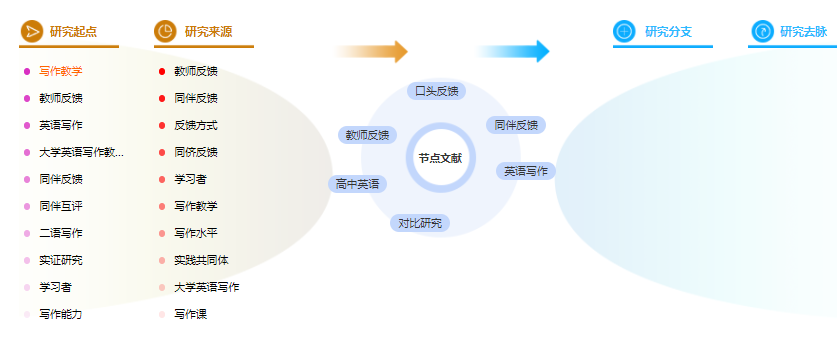博士论文提纲出不来怎么办?本文以英语论文为例,为大家列举了3篇论文提纲范文,多参考学习,希望对你的论文写作有帮助。

论文提纲范文样本一:中国英语学习者逻辑状语从句位置选择竞争模式的多因素研究
摘要
Abstract
Acknowledgements
Abbreviations
Chapter 1 Introduction
1.1 Background of the study
1.2 Motivation for the study
1.2.1 Focus of the study
1.2.2 Questions to be answered
1.2.3 Brief methodology introduction
1.3 Outline of the thesis
Chapter 2 Literature Review
2.1 Competition mechanisms of language choice in second language acquisition
2.1.1 Cognitive capacity allocation and motivator competition
2.1.2 Research modes and major findings
2.1.3 Methods employed in motivator competition studies
2.2 Influential factors
2.2.1 Classic studies on adverbial clause positioning
2.2.2 Motivators fit for multifactorial analyses
2.2.3 Factors that influence second language acquisition
2.3 Studies on adverbial clause positioning by learners
2.3.1 Learners' performance in temporal adverbial clause positioning
2.3.2 Mono-factorial studies on learners' logical adverbial clause positioning
2.3.3 Multifactorial analyses of learners' choice in logical adverbial clause positioning
2.4 Research gaps
Chapter 3 Cause-Based Subordination Hierarchy
3.1 The multi-functional subordinators
3.1.1 because and since
3.1.2 although and though
3.1.3 if
3.2 Cause-based logical subordinations
3.2.1 Clausal relationship generalization
3.2.2 Cause as the shared property
3.2.3 Specific relationship distribution
3.3 Summary
Chapter 4 Data and Methods
4.1 Corpora
4.1.1 Corpora selection
4.1.2 Data extraction
4.2 Sentence segmentation
4.3 Annotation
4.3.1 Annotation terminology
4.3.2 Annotation process
4.4 Methods
4.4.1 Mono-factorial effect size calculation
4.4.2 Binary logistic regression modeling
4.4.3 Ranking via repeated k-fold cross-validation modeling
4.5 Data sets marked with clausal relationships
Chapter 5 Variable Distribution Patterns
5.1 Independent variable distribution
5.1.1 Variable distribution in general
5.1.2 Variable distribution within the subordination hierarchy
5.1.3 Variable distribution within the specific clausal relationship hierarchy
5.2 Dependent variable(position) distribution
5.2.1 General position distribution from native and learner corpora
5.2.2 Learner behavior reflected by variable distribution of position
5.3 Summary
Chapter 6 Motivator Competition Patterns
6.1 Motivator importance, direction and significance
6.1.1 Motivator significance in mono-factorial analysis
6.1.2 Motivator reports via binary logistic regression models
6.1.3 Motivator importance
6.2 Power index of the motivators
6.2.1 Elements involved in motivator power index
6.2.2 Motivator power index formula
6.2.3 Power index values
6.3 Three groups of motivator competition patterns
6.3.1 General competition patterns
6.3.2 Most competitive motivator(s)
6.3.3 Competitive motivators
6.3.4 Weak motivators
6.4 Summary
Chapter 7 Discussion
7.1 Cognitive and functional motivations in native performance
7.1.1 Motivation-linguistic phenomenon correspondence in previous literature
7.1.2 Observance of principle of iconicity of sequence
7.1.3 Load optimization
7.1.4 Salience effects of clausal relationships
7.1.5 Observance of principle of iconicity of markedness
7.1.6 Generalizing native motivations correspondent to linguistic phenomena
7.2 Cognitive capacity allocation on motivations by native speakers
7.2.1 Frame work of natives' cognitive capacity allocation
7.2.2 Complementation to the frame work from natives' variable distribution
7.2.3 Competition mechanisms on native speakers' part
7.3 Cognitive and functional motivations in learner performance
7.3.1 Cognition friendliness
7.3.2 L1 influence
7.3.3 Learner practicalism
7.3.4 Generalizing learner motivations correspondent to linguistic phenomena
7.4 Cognitive capacity allocation on motivations by learners
7.4.1 Frame work of learners' cognitive capacity allocation
7.4.2 Complementation to the frame work from learners' variable distribution
7.4.3 Competition mechanisms generalization in learner performance
7.5 Summary
Chapter 8 Conclusion
8.1 Major findings
8.1.1 Variable distribution patterns
8.1.2 Motivator competition patterns
8.1.3 Competition mechanisms in adverbial clausal positioning by learners
8.2 Implications of the study
8.2.1 Theoretical implications
8.2.2 Pedagogical implications
8.3 Limitations of the study
8.4 Suggestions for future research
References
Appendices
Appendix 1. Variable distribution tables
Appendix 2. Mosaic plots of native data sets
Appendix 3. Mosaic plots of learner data sets
Appendix 4. Logistic regression modelling of native speakers
Appendix 5. Logistic regression modelling of Chinese EFL learners
Appendix 6.Variable importance value and ranking—native modelling
Appendix 7. Variable importance value and ranking—learner modelling
Appendix 8. Native variable importance values and rankings plots
Appendix 9. Learner variable
论文提纲范文样本二:中国学生在线英语写作同伴互评学习投入历时性研究
Abstract
摘要
List of Abbreviations
Chapter 1 Introduction
1.1 Research Background
1.1.1 Peer Review Practice in L2 Writing
1.1.2 Student Engagement in Peer Review Activities
1.1.3 Issues in Argumentative Writing
1.2 Theoretical Rationale
1.3 Objectives and Necessity of the Present Study
1.4 Thesis Structure
Chapter 2 Literature Review
2.1 Peer Review in ESL/EFL Writing
2.1.1 Defining Peer Review and Peer Feedback
2.1.2 Studies on Peer Comments
2.1.3 Reported Effectiveness of Peer Review
2.1.4 Factors Influencing the Effectiveness of Peer Review
2.2 Understanding Student Engagement
2.2.1 Earlier Conceptualization
2.2.2 Engagement as a Process and Outcome
2.2.3 Engagement as an Indicator and Facilitator
2.3 Constructs of Student Engagement
2.3.1 Emotional Engagement
2.3.2 Behavioral Engagement
2.3.3 Cognitive Engagement
2.3.4 The Interplay of Engagement Dimensions
2.4 Assessing Student Engagement
2.4.1 Self-report Surveys
2.4.2 Interviews
2.4.3 Observations
2.4.4 Textual Analysis
2.5 Empirical Studies of Student Engagement with L2 Learning
2.5.1 Frameworks of Domain-specific Student Engagement
2.5.2 Relationships between L2 Students’ Engagement and Learning Outcomes
2.6 Student Engagement in Peer Review of Writing
2.7 Summary
Chapter 3 Theoretical Foundations and Analytical Framework
3.1 The Process Approach to Writing
3.1.1 Concepts of the Process Writing Approach
3.1.2 Peer Review and the Process Writing Approach
3.2 Cooperative Learning Theory
3.3 Flow Theory
3.3.1 Flow Theory in Educational Psychology
3.3.2 Flow and Language Acquisition
3.4 Conceptual Framework of Student Engagement in Online Peer Review
Chapter 4 Research Design
4.1 An Overview
4.2 Research Questions
4.3 Course Context
4.3.1 Macro Context of EFL Writing Instruction in China
4.3.2 Teaching Objectives and Procedures
4.3.3 Training to Facilitate Active Engagement in Peer Review
4.3.4 Peer Review Support Structure
4.3.5 Procedures of Online Peer Review Activities in Two Semesters
4.4 Participants of the Study
4.5 Instruments
4.5.1 A Self-report Scale for Assessing Student Reviewers’ Engagement
4.5.2 Interviews
4.5.3 English Proficiency Tests
4.5.4 Reflective Journals
4.6 Data Sources and Coding Processes
4.6.1 Peer Comments and Students’ Writing Drafts
4.6.2 Coding Idea Units of Peer Comments
4.6.3 Sentiment Analysis of Students’ Reflective Journals
4.6.4 Assessing the Quality of English Argumentative Essays
4.7 Analytical Framework for the Present Study
Chapter 5 Student Engagement in Online Peer Review
5.1 Behavioral Engagement
5.1.1 Levels of Behavioral Engagement
5.1.2 Salient Features of Behavioral Engagement
5.1.3 Development Trajectories of Behavioral Engagement
5.2 Cognitive Engagement
5.2.1 Levels of Cognitive Engagement
5.2.2 Salient Features of Cognitive Engagement
5.2.3 Development Trajectories of Cognitive Engagement
5.3 Emotional Engagement
5.3.1 Sentiment Values of Polarity
5.3.2 Distinctive Emotional Traits
5.3.3 Development Trajectories of Emotional Engagement
5.4 Comparing HP and LP Students’ Engagement
5.5 Correlation of the Three Dimensions of Engagement
Chapter 6 Self-report Engagement and Its Correlation with Substantive Engagement
6.1 Peer Reviewers’ Self-report Engagement
6.1.1 Online Performance
6.1.2 Value Recognition
6.1.3 Feedback Strategies
6.1.4 Task Management
6.1.5 Reviewer Confidence
6.1.6 Interpersonal Communication
6.2 Correlation among the Six Factors
6.3 Comparing Self-report Engagement between the HP and LP Students
6.4 Correlation between Self-report and Substantive Engagement
Chapter 7 Performance Outcomes of Student Engagement
7.1 Thoughts on Choosing Performance Outcome Indicators
7.2 Peer Comment Quantity
7.2.1 Development of Comment Word Count
7.2.2 The Longer, the Better?
7.3 Peer Comment Quality
7.3.1 Proportion of Peer Comment Quality Indicators
7.3.2 Changes of Peer Comment Quality Grades
7.3.3 Deficiencies of Peer Comments
7.4 Development of Argumentative Writing
7.4.1 Overall Quality
7.4.2 Argument Components
7.4.3 Effectiveness of Argumentation
7.4.4 Grammar and Vocabulary
7.4.5 Language Style
7.5 Comparing Performance Outcomes between HP and LP Students
7.5.1 Peer Comment Quantity
7.5.2 Peer Comment Quality
7.5.3 Argumentative Writing Development
7.6 Correlations between Student Engagement and Performance Outcomes
7.6.1 Engagement and Peer Comment Quantity
7.6.2 Engagement and Peer Comment Quality
7.6.3 Engagement and Argumentative Writing Development
Chapter 8 Discussion
8.1 Issues in Students’ Substantive Engagement
8.1.1 Substantial Behavioral Efforts Invested into Revision-oriented Criticism
8.1.2 Active Cognitive Engagement as Evident in Peer Comments
8.1.3 Positive Emotional Engagement over Time
8.2 The Match between Students’ Self-report and Substantive Engagement
8.2.1 Self-report Scale Presenting a Comprehensive Snapshot of Engagement
8.2.2 Flow Experience Fostering the Perception of Being Engaged
8.2.3 Empowerment Mechanisms to Optimal Engagement in Online Peer Review
8.3 The Impact of Engagement on Performance Outcomes
8.3.1 Positive Correlations between Engagement and Performance Outcomes
8.3.2 Feedback Givers’ Development of Reader Awareness
8.3.3 EFL Writing Development along with Engagement
8.4 Revised Conceptual Framework for Engagement in Peer Review
Chapter 9 Conclusion and Implications
9.1 Major Findings
9.2 Pedagogical Implications
9.2.1 Supporting Student Engagement in Offering Peer Feedback
9.2.2 Gaining an Insight into Pedagogical Innovation
9.2.3 Empowering EFL Learners to Writing
9.3 Limitations and Implications for Future Research
References
Appendix 1 Peer Review Comment Prompts and Scoring Rubric for EFL Argumentative Writing
Appendix 2 Self-report Scale of Student Engagement in Peer Review of EFL Writing
Appendix 3 Interview Protocol
Appendix 4 Assessment Sheet for Expert Raters
Appendix 5 List of Publications during Doctoral Study
Acknowledgements

论文提纲范文样本三:晚清时期英语在中国的传播研究
摘要
Abstract
第一章 绪论
第一节 研究背景及意义
1.研究背景
2.研究意义
第二节 研究问题与论文结构
1.研究问题
2.论文结构
第三节 研究方法与理论依据
1.研究方法
2.理论基础与认识依据
第二章 文献综述及研究回顾
第一节 相关概念
1.英语传播
2.晚清时期
3.晚清时期传教士
第二节 英语传播的相关研究
1.国外英语传播的相关研究
2.国内英语传播的相关研究
第三节 晚清以前英语传播回顾
第四节 晚清社会英语传播研究
1.晚清社会传教士的相关研究
2.晚清社会翻译情况的相关研究
3.晚清社会近代化教育的相关研究
第三章 晚清时期英语在中国传播的文化路径
第一节 传播的文化背景
第二节 传播主体:来华传教士
第三节 教会学校与英语传播
1.前期教会学校与英语传播
2.后期教会学校与英语传播
第四节 翻译出版与英语传播
1.翻译机构与英语传播
2.报刊出版与英语传播
第五节 传教士主导的英语传播的文化特征
1.双向语言文化传播
2.群体性书面语传播
第六节 本章小结
第四章 晚清时期英语在中国传播的经济路径
第一节 传播的经济背景
第二节 传播主体:来华英美商人
第三节 民间英语培训机构与英语人才培养
第四节 “皮钦”英语与英语传播
第五节 英美商人主导的英语传播的经济特征
第六节 本章小结
第五章 晚清时期英语在中国传播的政治路径
第一节 传播的政治背景
第二节 传播主体:晚清政府洋务派
第三节 近代化教育与英语传播
1.三类新式学校与英语传播
2.官派留美与英语传播
第四节 翻译活动与英语传播
1.江南制造局翻译馆与西学传播
2.京师同文馆翻译活动与译员培养
第五节 洋务派主导的英语传播的政治特征
第六节 本章小结
第六章 晚清社会英语传播规律及其影响
第一节 外来语言传播竞争激烈
1.其他外语的传播情况
2.影响外语竞争的因素
第二节 路径依赖及其体现
1.路径依赖及其内涵
2.英语传播路径依赖
第三节 英语传播中人的因素
1.晚清来华西方人
2.晚清政府洋务派
3.个体被动传播者
第四节 传播受众:底层-精英-群众的传播模式
第五节 文化、经济、政治层面的平行交互传播
第六节 英语在中国传播带来的影响
1.对汉语的影响
2.对社会的影响
第七节 本章小结
第七章 晚清时期英语在中国传播的局限及启示
第一节 主导性局限及表现
1.来华西人主导的传播的局限性
2.洋务派们主导的传播的局限性
第二节 对汉语国际传播的启示
1.应对传播中的竞争现象
2.注重主导者的路径依赖
3.尊重受众传播相关规律
4.结合“场论”防范预警
第三节 对外语政策与规划的启示
1.应对英语的语言霸权
2.提高中华文化自信心
第四节 本章小结
第八章 总结
第一节 结论与贡献
第二节 不足与展望
参考文献
以上是英语论文提纲范文样本,如果你了解更多关于论文写作的资料或者注意事项,可以在本网站查阅;如果需要论文写作的帮助,可以在线咨询

